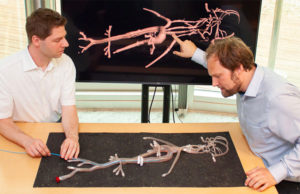
Clinicians around the world perform millions of endovascular procedures per year, using catheters and guided by X-rays to place stents or remove blood clots. That’s a lot of radiation for patients and physicians to endure, and the X-rays don’t even provide the most precise images, according to Torben Pätz, a mathematician at the Fraunhofer Institute for Digital Medicine (MEVIS) in Bremen, Germany.
Fraunhofer MEVIS is developing a system to remedy these problems.
The “intelligent catheter navigation” or Intellicath method uses a catheter equipped with a special optical fiber containing tiny “mirrors.” When light passes through the fiber, the mirrors reflect a portion of the light. Whenever the fiber bends, the reflected light changes color. Sensors can then measure the change in color.
“The signal from the sensors gives us information about the intensity and direction of the curvature,” Pätz said in a news release. “To some extent, the fiber knows how it is formed.”
An additional element is needed, however, for precise navigation through the vascular system. Before the procedure, physicians obtain CT or MR images of a patient. Based on this image data, IntelliCath software creates a 3D model of the vessel system and displays it on a monitor. During the endovascular procedure, live data from the fiber navigation is fed into the model. The doctor views the monitor to see how the device moves through the vascular labyrinth live and in 3D.
MEVIS experts have already been able to test the method’s feasibility using a prototype, according to Pätz. “We connected several silicone hoses into a curved labyrinth,” he said. “Then, we inserted our device containing an optical fiber into the labyrinth.” On the monitor, they were able to locate the catheter’s position in real-time with precision approaching five millimeters. The researchers have already applied for two patents.
Although several medical device companies work on similar projects, “they expend a great deal of technical effort into trying to reconstruct the shape of the entire catheter, which can be up to two meters long,” Pätz said. “Our algorithm, however, only needs a fraction of the data to localize the catheter in a known vascular system.”
As a result, the MEVIS approach promises cost-effective technology without special fibers and measurement systems and is less sensitive to measurement errors than previous approaches, according to the institute.
Next, the researchers will test the IntelliCath system on both a full-body phantom of the human vascular system and on a pig lung. Toward the end of the current project phase in 2020, a prototype will be ready to serve as a foundation for a clinical trial.
Pätz and his team are also developing acoustic feedback to relieve doctors of the constant need to look at the monitor. The idea is to employ various indication sounds to signal how far the next vessel junction is and in which direction the catheter should be inserted.
“It is similar to a car’s parking assistance system, where you also receive acoustic indications about the distance to the next obstacle,” Pätz said.

